The second set of dinosaurs in the Z-Cardz line reveals some surprising, if questionable, choices going on in the lineup for these little collectibles.
Constructible strategy games are a concept typically involving 3D punch-out card minifigures, which can be collected and utilized for play in large-scale games between players. Although the term (abbreviated as CSG) was first coined by WizKids in 2004, another company by the name of California Creations began experimenting with collectible 3D cards in 2001 and 2002, with an extensive line of varied figures titled Z-Cardz. Among numerous themes including cars, animals, and even superheroes, Z-Cardz included four series of dinosaur and prehistoric creatures, with five figures each. These minifigures typically measured from 2.5-3 inches long each and could come packaged individually, randomly as a pack with other series models, or as the complete series set. For this review, I’ll be covering the Dinosaurs Series 2 set, which, like the Series 1 set previously covered, has some surprises for a cheap kids’ collectible line.
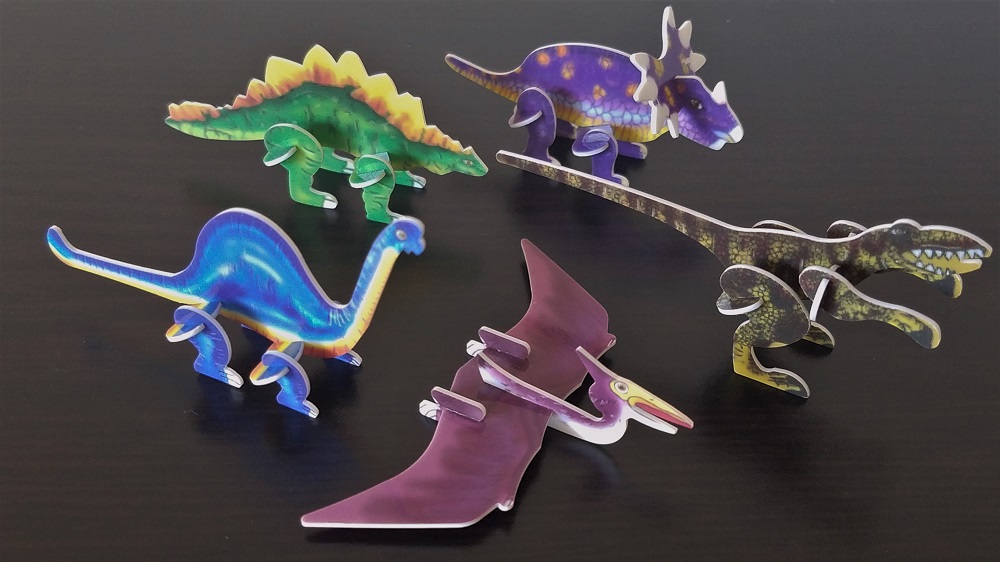
The first figurine in this set, card #206, is the ever-iconic Apatosaurus, depicted in a very retro fashion. With its blunt head, erect neck, low-slung tail, and massively sloped back, this model almost feels like a caricature of old 20th Century reconstructions of the animal. A prominent bump or crest atop the head makes me also wonder if the designers were referencing Brachiosaurus by accident. The model has very short, stubby legs, but correctly features longer hind legs than front ones. Touches of wrinkled skin texture are applied to the neck and limbs, with large scales on the face and toes; the rest of the body appears smooth. The main coloration of the model is shifting gradients of deep blue, with a bright yellow-and-orange underbelly. It’s a somewhat charming little model of a old-school, long-necked dinosaur.

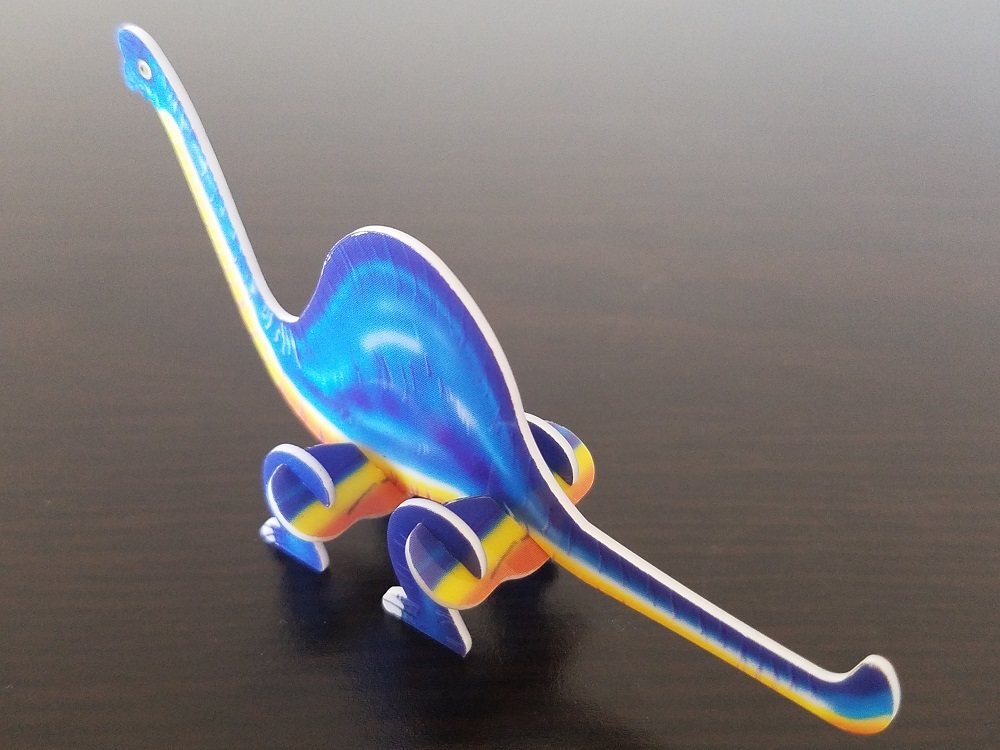
Card model #207 is simply labeled as “Pterosaur,” and why the design team chose a generic group name over a distinct genus name is unknown to me. Pterosaurs, of course, are not dinosaurs but a separate related group of archosaurs; however many people still confuse them today, so it’s really no surprise to see one of the winged reptiles here. The “pterosaur,” judging by the crest on the back of its head, appears to be based on the genus Pteranodon, but there’s not much else to really go on. The model is posed mid-flight, with wings straight out and neck arched up and back like a heron or stork–an unlikely or impossible pose for most pterosaurs, and certainly for Pteranodon, which had a very short neck. The wings are deep and pointed, reflecting classic imagery of pterosaurs but not really reflecting more contemporary understanding of the animals’ biology. The hind legs attach directly to the main body and wings piece, but the manner in which they do so makes the legs appear almost backwards; the result is weird to look at. The bill appears to have some interesting segmentation to it, like that of some seabirds, but to my knowledge this doesn’t match any known pterosaur fossil material. The crest itself is fairly small and undefined, but creative players might be able to label this as a female. The model is overall painted in washes of purple and magenta with a white throat and multicolored bill. I don’t see purples too often in prehistory figures, so it’s a nice choice for an otherwise generic model.
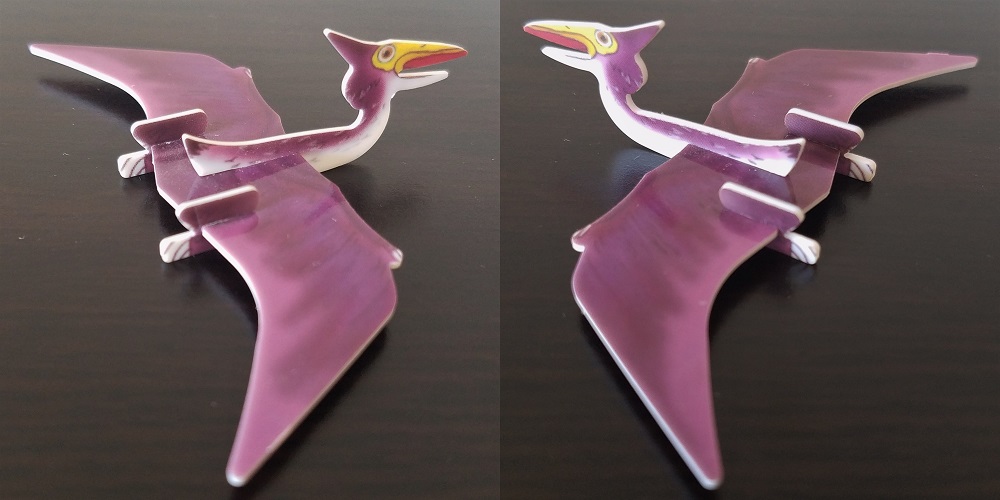

Card model #208 brings a truly unexpected choice of selection in the name of Daptosaurus. If this genus is unfamiliar to you, don’t worry–the name Daptosaurus hasn’t been in use since at least 1969, when the animal in question became formally described as Deinonychus. Exactly why, or even HOW the Z-Cardz creative team managed to settle on this defunct name instead of the official (and much more recognizable) scientific name utterly perplexes me. It does add a certain novelty to the model, at least–I can’t say I’ve ever heard of another Daptosaurus collectible before. Regarding the model’s actual appearance, Daptosaurus is portrayed with an appropriately compact body and long, narrow tail seen in deinonychosaurs, although the tail does give the model balancing issues. The limbs aren’t very well-defined, with the legs posed in a slight crouch and arms stuck straight out, indicating some manner of pouncing position. The large, clawed hands and feet are rendered as little more than mitten paws, which is regrettable, considering the great killing claw on the foot is what makes Deinonychus and its relatives so famous. The head and eyes are big and oblong, with sizeable teeth bared in the jaws. The coloration might be the model’s best trait; it’s decked out in patterns of military green, brown, and yellow, with a subtler, irregular scaling pattern than some of the other Z-Cardz genera. This model isn’t going to win any awards among Deinonychus toys, but hey, as a Daptosaurus model it’s one-of-a-kind!
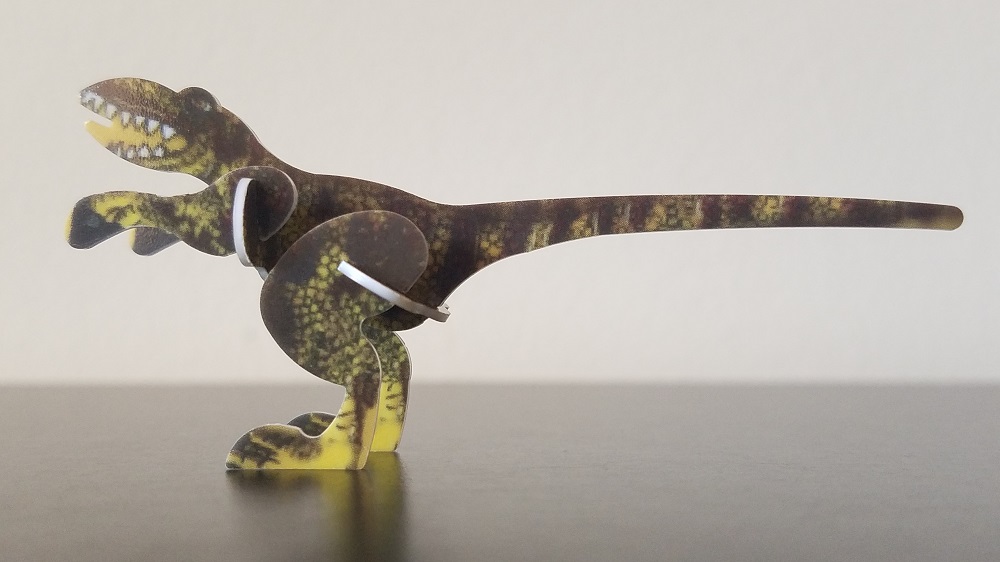
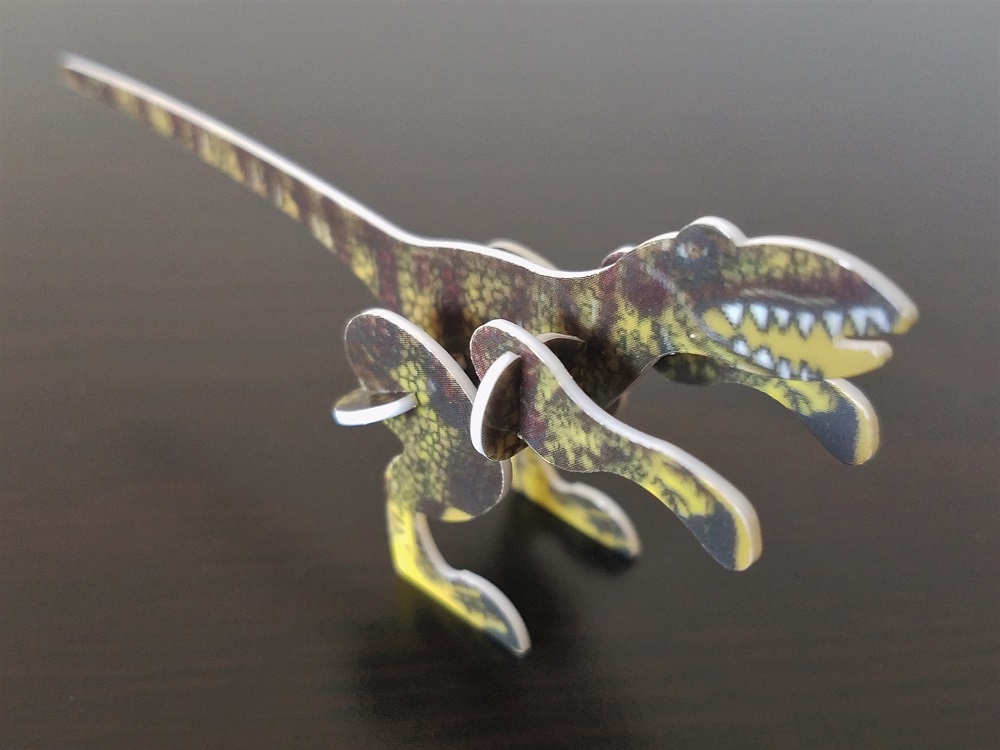
Card model #209 is Stegosaurus, a much more familiar genus. This model is on the slightly smaller side, and generally looks less defined in appearance. The iconic plates and spikes along the animal’s back and tail run together without much distinction. The body and limbs are sort of generically lumpy and misshapen, and the head is small and nondescript. The painted texture is randomly wrinkly, and little regard is given to the overall proportions of the animal. As a curious aside, the model is posed with head and tail level above the ground, and a reduced slope to the back. During the 2000s, this would have appeared inaccurate, however, this is actually more in line with recent discoveries and studies of the genus, so by a happy accident, the Z-Cardz Stegosaurus can be seen as somewhat ahead of its time. Less ahead of its time is the green and orange-yellow color pattern, which some collectors have noticed is becoming something of a cliché for the genus. All in all, this is the least remarkable model of this set.
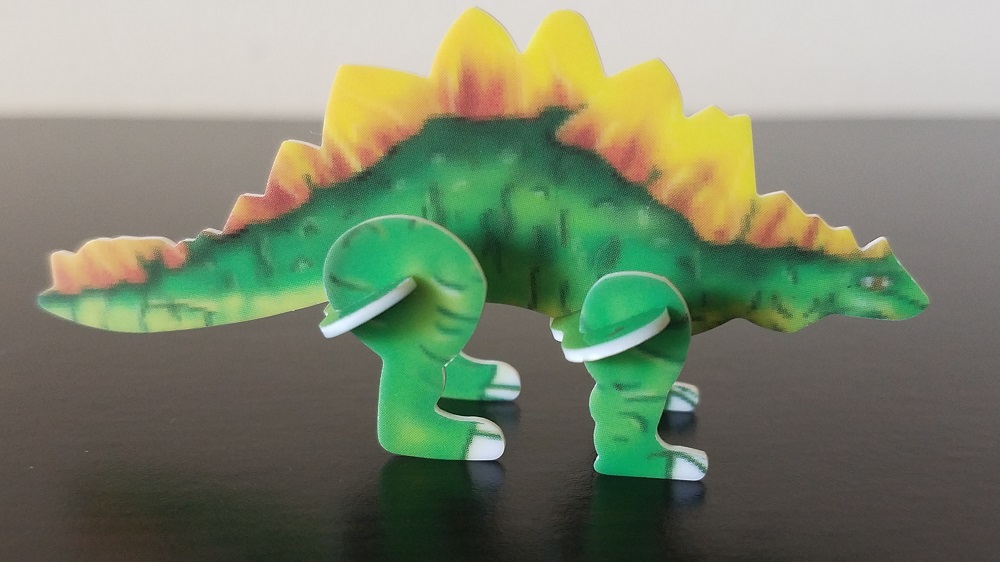

Card model #210, the last model in this set, is the ceratopsian Styracosaurus. This stout little model is also on the smaller side, although its plump body and large frill disguise that somewhat. It is a bit cartoonish-looking with its blocky head and beak, plus its undersized nose horn which tilts back instead of straight out. The flattened-out spread of the frill has a shape that looks less like the animal’s bony ornaments and more like a stylized frilled lizard. Not much definition is given to the body and tail, besides being respectively girthy and skinny. The coloration is quite nice on the model: rich purple is decorated with yellow and orange spots on the frill and backside, with light blue-and-yellow striping on the underbelly. It’s speculated that dinosaurs could have seen in color; this horned dinosaur certainly wouldn’t have trouble signaling to others of its species.

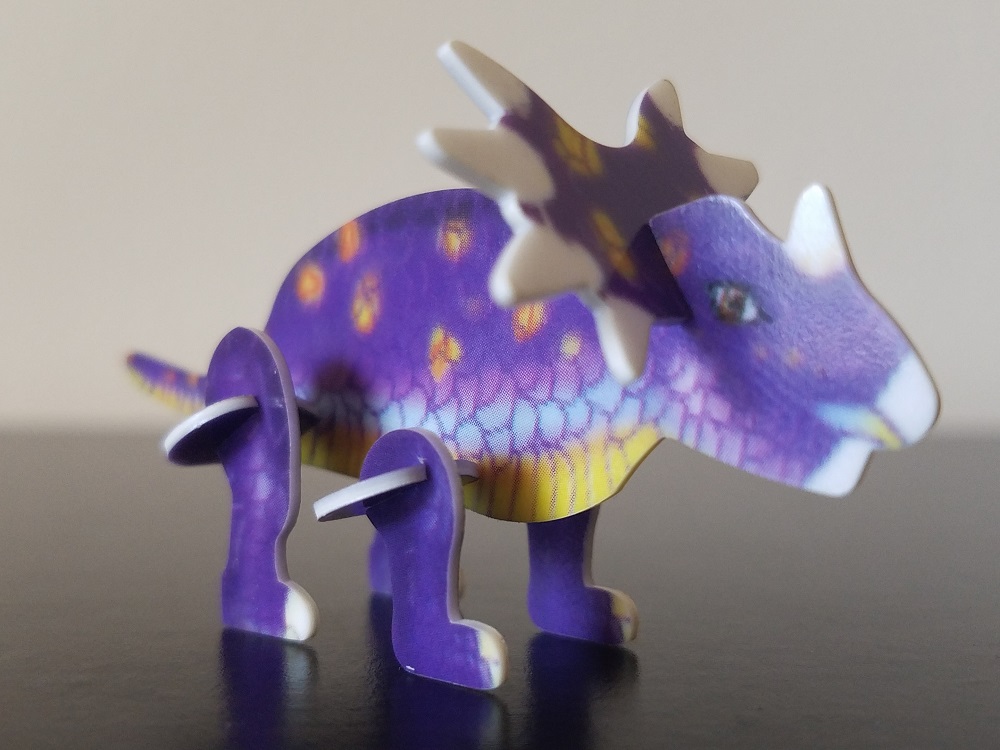
Z-Cardz were meant to be a cheap and readily available line of merchandise for kids, so given their size and style, one probably shouldn’t be too hard on them. The Dinosaurs Series 2 set obviously is meant for fun, not education, and that’s not even accounting for some of of the stranger decisions made here. Both Z-Cardz and their parent company, California Creations, appear to have been defunct for a while, so any intrigued collectors are advised to head over to eBay to start their hunt.

Disclaimer: links to Ebay and Amazon on the DinoToyBlog are affiliate links, so we make a small commission if you use them. Thanks for supporting us!




Funny about that “Daptosaurus.” It’s just like how Recur named their Triceratops “Sterrholophus Marsh” instead.